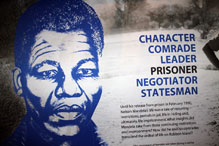 A piece on show at the Mandela exhibition
A piece on show at the Mandela exhibitionFebruary 11, 2010 – Guest speaker Cyril Ramaphosa spoke of the “magic in the air” on the day of Mr Nelson Mandela’s release at the opening of two major exhibitions, Mandela: Character, comrade, leader, prisoner, negotiator, statesman; and Drawing on Madiba by Zapiro, at the Iziko Museums’ Slave Lodge in Cape Town last night. Twenty years ago today, on February 11, 1990, Mr Mandela walked free from prison.
“Today we particularly remember the contribution that Nelson Mandela has made to make us all that we are today,” said Ramaphosa. “This evening allows us to cast our minds back to the evening before Madiba was to walk free. Though we understood that momentous changes were taking place in our country, we didn’t quite understand what the events that were unfolding would lead to. We had great expectations, but great uncertainty.”
Ramaphosa, who was on the reception committee to welcome Mr Mandela, said they were told only 24 hours before his release. “We panicked because we knew we were not ready. We thought the apartheid rulers were playing a very dirty trick on us.”
There were logistics to organise: “We made the practical arrangements; we planned where he would speak; we had to arrange his travel; where he would stay … We had no idea how the country would respond to him. And did this indeed herald the beginning of our transformation – or was it just a ploy?”
Ramaphosa pointed out that the thousands of people who turned out to meet Mr Mandela on that day knew little about him. “They knew him as a symbol; as a representation of the struggle of our people…
“After 20 years, we now know that the myth and reality came to merge, and the real Madiba surpassed the myth. We were delighted and relieved that what we had learned about him turned out to be true.”
Ramaphosa recalled, “The release of Mandela was not an isolated moment; it was not a miracle; nor was it achieved out of the goodness of anyone’s heart. … It was the result of the intensification of the fight against apartheid. It was not the moment South Africa became free,” he said, for the country was still to experience much violence. “But it was the day we knew for certain that things in South Africa would never be the same again.”
Ramaphosa acknowledged “those in the National Party who had the courage to unban the banned organisations and to free political prisoners. There was a sincere recognition by some in the ruling class that the future of black and white South Africans would be together. At the time, many did not realise that we were the same people.”
While Ramaphosa said there was much work to be done in South Africa in terms of creating jobs, providing housing and electricity, and fighting crime and poverty, among other things, “In remembering that day, we remember that we were able to overcome seemingly insurmountable problems. … There was magic in the air as Madiba walked out of prison.”
The opening was attended by many of Mr Mandela’s long-time friends and colleagues, including his first minister of finance, Chris Liebenberg; Leon Wessels, who represented the National Party while drawing up the Constitution; former Deputy President Phumzile Mlambo-Ngcuka, and fellow Robben Island-inmate Ahmed Kathrada, who spoke of his friend with fondness.
“Madiba is a very cool, calm person,” said Kathrada, telling a story about how, while in prison in 1985, Mr Mandela told his fellow prisoners he’d been chatting with then-State President PW Botha. As Mr Mandela casually read the paper, reminisced Kathrada, he said, “By the way, chaps, he’s offered to release us.”
“He’s a very tenacious and determined person,” continued Kathrada, telling the audience how, at Christmas-time on Robben Island, the prisoners played games against one another. Madiba played a chess match against a new prisoner, a bright young Wits student. “Every move of his, as in politics, is well calculated.” They played all day and still hadn’t finished, so asked the warders to lock up the chessboard with the pieces in place for the night, and they started playing again the next day. “Eventually,” said Kathrada, “This young man said, ‘have your victory!’ And he did, as he did in politics.”
Kathrada commented, too, on Mr Mandela’s kindness. Also, at the end of the year, he recalled, the prisoners were given a small allowance of sweets and biscuits, which they all gobbled up, except for Madiba. Mr Mandela shared a birthday with another prisoner, Fikile Bam, and every year, he would save his treats for six months to give to Bam on his birthday.
Kathrada also gently joked about Madiba’s vanity, and how he loved to use a hair product called Panteen. “They stopped making it, but he wouldn’t believe it.” (Mr Mandela thought it was a cruel trick being played on him by his captors). Eventually, his warder, Christo Brand, found him some in Cape Town. And then, on the eve of his 80th birthday, remembered Kathrada, “Walter Sisulu and I got two bottles of Panteen for him from the USA!”
He also told the story of how, before his capture and imprisonment, Mr Mandela also refused to shave off his beard, even when he went into hiding. The committee protecting him knew he was more at risk of being recognised and captured with his beard. “He was forced to shave it off when we landed in prison.”
On a more serious note, he said, “This 11 February didn’t fall from the heavens suddenly. It was a process that started in 1985. It started with letters, meetings with ministers, the civil service – everyone is ignoring this.” In 1985, Kathrada reminded the audience, Botha offered Mandela his freedom, under certain limitations. “Prisoners don’t negotiate,” Mandela said to him.
“[FW] de Klerk has admitted that he did it [released Mr Mandela] under pressure. Cyril [Ramaphosa] and his crowd made this country ungovernable.”
Said Iziko Museums chairperson, Elias Links, “It’s imperative that we preserve our remarkable heritage; that we bequeath it to future generations.
“Iziko is privileged to host this exhibition, and the Slave Lodge is a perfect place for this launch. It speaks of our struggle for freedom, but also signals our determination.”
Achmat Dangor, CEO of the Nelson Mandela Foundation, said after the event: “I think what is significant [about the exhibition] is that we are able to take Nelson Mandela and his story to people who really appreciate his legacy. There is not one person here who expected him to be here in person. Nelson Mandela’s legacy can live on and beyond him.”
Leon Wessels said, “It was wonderful to have a ringside seat when history was made. I’m looking forward to the next 20 years!”
Cartoonist Jonathan Shapiro, also known as “Zapiro”, whose exhibition of cartoons of Mr Mandela is running concurrently at the Iziko Museums’ Slave Lodge, said, “It’s fantastic to be twinned with the Mandela exhibition. I feel honoured.”
Said Madiba’s ex-prison warder, Christo Brand, who saw Mr Mandela last week: “I feel happy that he’s still here with us – we never thought he would last this long!”
Brand remembered driving Madiba around on a few occasions before his release, to let him see something of the country he had been isolated from for so long. He took him first to the Steenberg vineyards, near his prison in Paarl, where he walked among the vines and picked a few grapes. Another time, he took him to a dam near the Pollsmoor Prison, where some children were fishing. Madiba walked up to them and chatted with them – of course they had no idea who he was.
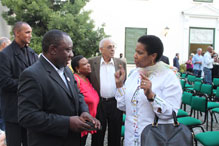 Cyril Ramaphosa and Phumzile-Mlambo Ngcuka at the opening of the exhibition
Cyril Ramaphosa and Phumzile-Mlambo Ngcuka at the opening of the exhibition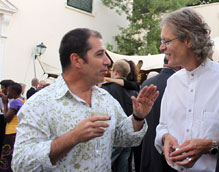 Cartoonist Jonathan Shapiro with Verne Harris of the Nelson Mandela Foundation
Cartoonist Jonathan Shapiro with Verne Harris of the Nelson Mandela Foundation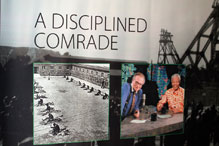 One of the panels on show
One of the panels on show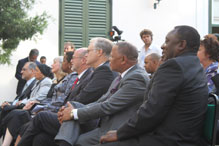 Guests at the opening of the exhibition
Guests at the opening of the exhibition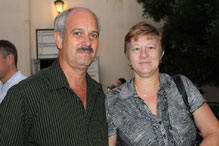 Madiba’s prison warder, Christo Brand, and his wife, Estelle, also attended the opening of the exhibition
Madiba’s prison warder, Christo Brand, and his wife, Estelle, also attended the opening of the exhibition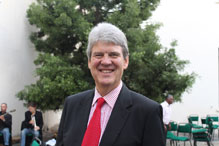 Leon Wessels, commissioner to the South African Human Rights Commission
Leon Wessels, commissioner to the South African Human Rights Commission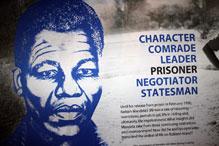 A piece on show at the Mandela exhibition
A piece on show at the Mandela exhibition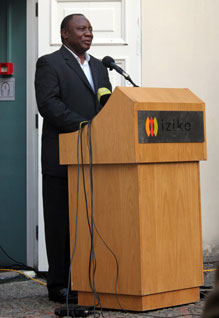 Cyril Ramaphosa remembering February 11, 1990
Cyril Ramaphosa remembering February 11, 1990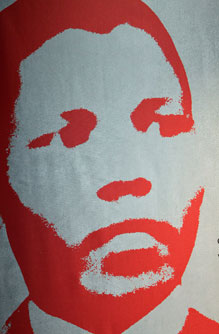 A poster of Nelson Mandela
A poster of Nelson Mandela